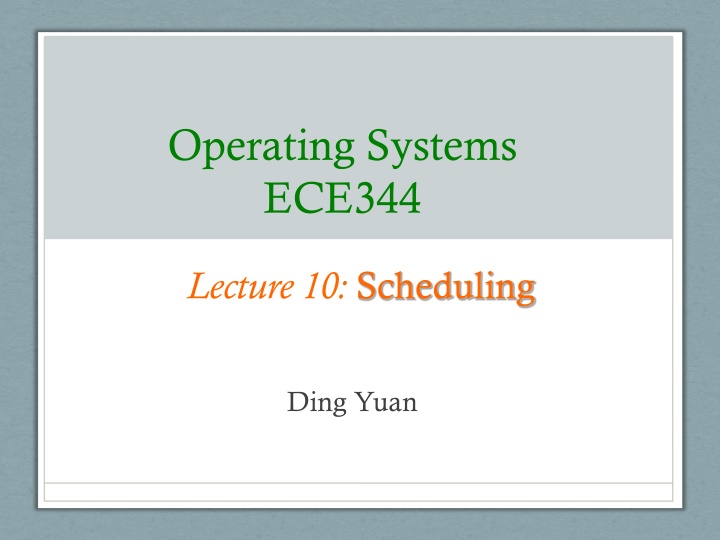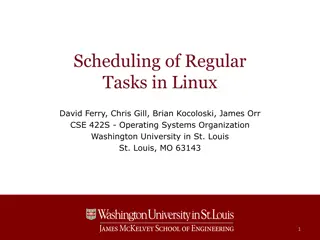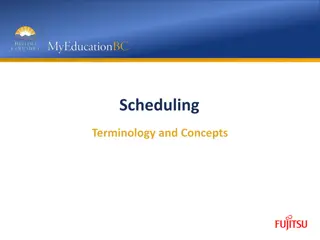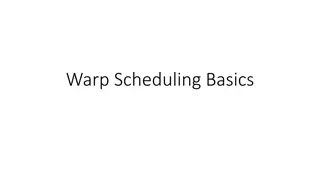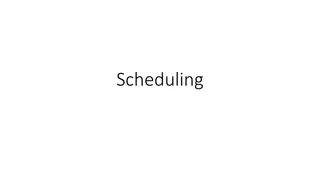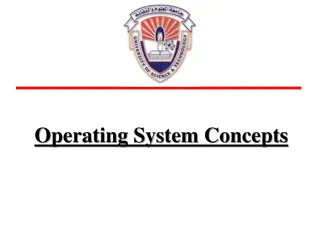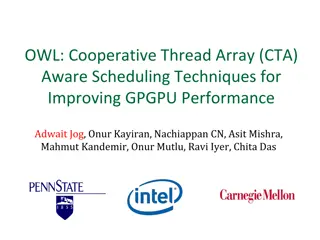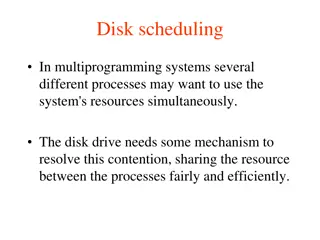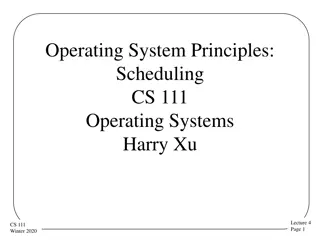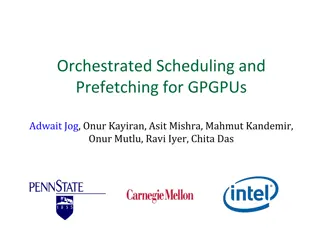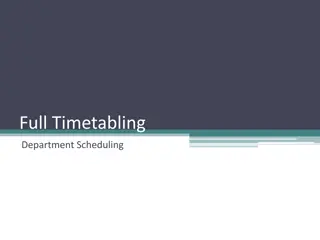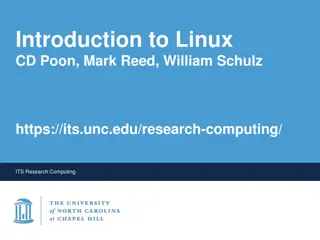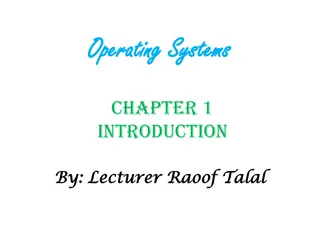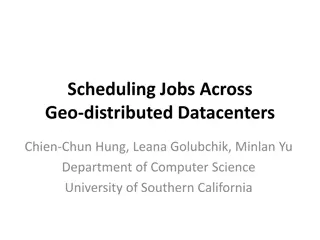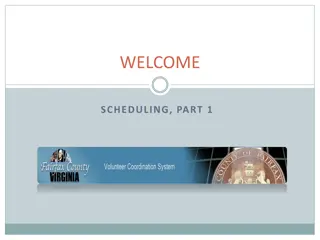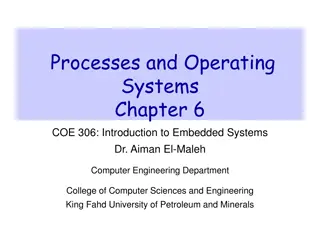Scheduling in Operating Systems: A Comprehensive Overview
This content delves into the intricate details of scheduling in operating systems, covering the goals, various scheduling algorithms, multiprogramming concepts, decision-making processes for resource allocation, timing considerations, scheduling objectives, and performance criteria such as throughput and turnaround time.
Download Presentation

Please find below an Image/Link to download the presentation.
The content on the website is provided AS IS for your information and personal use only. It may not be sold, licensed, or shared on other websites without obtaining consent from the author.If you encounter any issues during the download, it is possible that the publisher has removed the file from their server.
You are allowed to download the files provided on this website for personal or commercial use, subject to the condition that they are used lawfully. All files are the property of their respective owners.
The content on the website is provided AS IS for your information and personal use only. It may not be sold, licensed, or shared on other websites without obtaining consent from the author.
E N D
Presentation Transcript
Operating Systems ECE344 Lecture 10: Scheduling Ding Yuan
Scheduling Overview In discussing process management and synchronization, we talked about context switching among processes/threads on the ready queue But we have glossed over the details of exactly which thread is chosen from the ready queue Making this decision is called scheduling In this lecture, we ll look at: The goals of scheduling Various well-known scheduling algorithms Standard Unix scheduling algorithm 2 ECE344 Operating Systems Ding Yuan
Multiprogramming In a multiprogramming system, we try to increase CPU utilization and job throughput by overlapping I/O and CPU activities Doing this requires a combination of mechanisms and policy We have covered the mechanisms Context switching, how it happens Process queues and process states Now we ll look at the policies Which process (thread) to run, for how long, etc. We ll refer to schedulable entities as jobs (standard usage) could be processes, threads, people, etc. 3 ECE344 Operating Systems Ding Yuan
Scheduling Deciding which process/thread should occupy the resource (CPU, disk, etc.) 4 ECE344 Operating Systems Ding Yuan
When to schedule? A new job starts The running job exits The running job is blocked I/O interrupt (some processes will be ready) Timer interrupt Every 10 milliseconds (Linux 2.4) Every 1 millisecond (Linux 2.6) Why is the change? 5 ECE344 Operating Systems Ding Yuan
What are the scheduling objectives? Anyone? 6 ECE344 Operating Systems Ding Yuan
Scheduling Objectives Fair (nobody cries) Priority (lady first) Efficiency (make best use of equipment) Encourage good behavior (good boy/girl) Support heavy load (degrade gracefully) Adapt to different environment (interactive, real-time, multi-media, etc.) 7 ECE344 Operating Systems Ding Yuan
Performance Criteria Throughput: # of jobs that complete in unit time Turnaround time (also called elapse time) Amount of time to execute a particular process from the time it entered Waiting time amount of time process has been waiting in ready queue Meeting deadlines: avoid bad consequences 8 ECE344 Operating Systems Ding Yuan
Different Systems, Different Focuses Batch Systems (e.g., billing, accounts receivable, accounts payable, etc.) Max throughput, max CPU utilization Interactive Systems (e.g., our PC) Min. response time Real-time system (e.g., airplane) Priority, meeting deadlines Example: on airplane, Flight Control has strictly higher priority than Environmental Control 9 ECE344 Operating Systems Ding Yuan
Program Behaviors Considered in Scheduling Is it I/O bound? Example? Is it CPU bound? Example? Batch or interactive environment Priority Frequency of page fault Frequency of I/O 10 ECE344 Operating Systems Ding Yuan
Preemptive vs. Non-preemptive Non-preemptive scheduling The running process keeps the CPU until it voluntarily gives up the CPU Process exits Switch to blocked state 1 and 4 only (no 3 unless calls yield) Preemptive scheduling The running process can be interrupted and must release the CPU 11 ECE344 Operating Systems Ding Yuan
Scheduling Algorithms First Come First Serve (FCFS) Batch Systems Short Job First (SJF) Priority Scheduling Interactive Systems Round Robin Multi-Queue & Multi-Level Feedback Real-time Systems Earliest Deadline First Scheduling 12 ECE344 Operating Systems Ding Yuan
First Come First Serve (FCFS) Also called first-in first-out (FIFO) Jobs are scheduled in order of arrival to ready queue Real-world scheduling of people in lines (e.g., supermarket) Typically non-preemptive (no context switching at market) Jobs treated equally, no starvation 13 ECE344 Operating Systems Ding Yuan
FCFS Example 14 ECE344 Operating Systems Ding Yuan
Problems with FCFS Average waiting time can be large if small jobs wait behind long ones (high turnaround time) Non-preemptive You have a basket, but you re stuck behind someone with a cart Solution? Express lane (12 items or less) 15 ECE344 Operating Systems Ding Yuan
Shortest Job First (SJF) Shortest Job First (SJF) Choose the job with the smallest expected duration first Person with smallest number of items to buy Requirement: the job duration needs to be known in advance Used in Batch Systems Optimal for Average Waiting Time if all jobs are available simultaneously (provable). Why? Real life analogy? Express lane in supermarket Shortest important task first -- The 7 Habits of Highly Effective People 16 ECE344 Operating Systems Ding Yuan
Non-preemptive SJF: Example 0 17 ECE344 Operating Systems Ding Yuan
Comparing to FCFS 0 18 ECE344 Operating Systems Ding Yuan
SJF is not always optimal Is SJF optimal if not all the jobs are available simultaneously? 0 19 ECE344 Operating Systems Ding Yuan
Preemptive SJF Also called Shortest Remaining Time First Schedule the job with the shortest remaining time required to complete Requirement: again, the duration needs to be known in advance 20 ECE344 Operating Systems Ding Yuan
Preemptive SJF: Same Example 21 ECE344 Operating Systems Ding Yuan
A Problem with SJF Starvation In some condition, a job is waiting forever Example: Process A with duration of 1 hour, arrives at time 0 But every 1 minute, a short process with duration of 2 minutes arrive Result of SJF: A never gets to run 22 ECE344 Operating Systems Ding Yuan
Scheduling Algorithms First Come First Serve (FCFS) Batch Systems Short Job First (SJF) Priority Scheduling Interactive Systems Round Robin Multi-Queue & Multi-Level Feedback Real-time Systems Earliest Deadline First Scheduling 23 ECE344 Operating Systems Ding Yuan
Priority Scheduling Each job is assigned a priority FCFS within each priority level Select highest priority job over lower ones Rationale: higher priority jobs are more mission-critical Example: DVD movie player vs. send email Real life analogy? Boarding at airports Problems: May not give the best AWT indefinite blocking or starving a process 24 ECE344 Operating Systems Ding Yuan
Set Priority Two approaches Static (for systems with well-known and regular application behaviors) Dynamic (otherwise) Priority may be based on: Importance Percentage of CPU time used in last X hours Should a job have higher priority if it used more CPU in the past? Why? 25 ECE344 Operating Systems Ding Yuan
Priority in Unix 26 ECE344 Operating Systems Ding Yuan
Nobody wants to Be nice on Unix 27 ECE344 Operating Systems Ding Yuan
More on Priority Scheduling For real-time (predictable) systems, priority is often used to isolate a process from those with lower priority. Priority inversion: high priority task is indirectly preempted by medium/low priority tasks A solution: priority inheritance high priority job medium priority job low priority job 28 ECE344 Operating Systems Ding Yuan
Round-robin One of the oldest, simplest, most commonly used scheduling algorithm Select process/thread from ready queue in a round- robin fashion (take turns) Real life analogy? Problem: Do not consider priority Context switch overhead 29 ECE344 Operating Systems Ding Yuan
Round-Robin: example 30 ECE344 Operating Systems Ding Yuan
Time Quantum Time slice too large FIFO behavior Poor response time Time slice too small Too many context switches (overheads) Inefficient CPU utilization Heuristics: 70-80% of jobs block within time-slice Typical time-slice: 5 100 ms Wait: isn t timer-interrupt frequency 1ms on Linux 2.6? 31 ECE344 Operating Systems Ding Yuan
Combining Algorithms Scheduling algorithms can be combined Have multiple queues Use a different algorithm among queues Move processes among queues Example: Multiple-level feedback queues (MLFQ) Multiple queues representing different job types Interactive, CPU-bound, batch, etc. Queues have priorities Jobs can move among queues based upon execution history Feedback: switch from interactive to CPU-bound behavior 32 ECE344 Operating Systems Ding Yuan
Example 33 ECE344 Operating Systems Ding Yuan
Unix Scheduler The Unix scheduler uses a MLFQ ~170 priority levels Priority scheduling across queues, RR within a queue The process with the highest priority always runs Processes with the same priority are scheduled RR Processes dynamically change priority Increases over time if process blocks before end of quantum Decreases over time if process uses entire quantum 34 ECE344 Operating Systems Ding Yuan
Unix Scheduler priority value = nice + base + (recent CPU usage/2) The lower the value, the higher the priority nice --- static priority [-20, 20], default 0 base --- a constant (60 in Unix) recent CPU usage is also called CPU decay = (last value + CPU count used by this process) / 2 35 ECE344 Operating Systems Ding Yuan
Process C priority 60 Process B priority 60 Process A recent CPU 0 recent CPU 0 recent CPU 0 1 .. 60 priority 60 timer int. Context switch 0 30 60 60 0 1 .. 60 75 Context switch 0 1 .. 60 60 15 30 67.5 75 Context switch 7.5 8 9 .. 67 15 63.75 75 67.5 30 36 ECE344 Operating Systems Ding Yuan
Properties How will it treat processes that have been waiting for a long time? How about a process that do not finish quantum before giving up the CPU (voluntarily or blocked)? 37 ECE344 Operating Systems Ding Yuan
Motivation of Unix Scheduler The idea behind the Unix scheduler is to reward interactive processes over CPU hogs Interactive processes (shell, editor, etc.) typically run using short CPU bursts They do not finish quantum before waiting for more input Want to minimize response time Time from keystroke (putting process on ready queue) to executing keystroke handler (process running) Don t want editor to wait until CPU hog finishes quantum This policy delays execution of CPU-bound jobs But that s ok 38 ECE344 Operating Systems Ding Yuan
Scheduling Algorithms First Come First Serve (FCFS) Batch Systems Short Job First (SJF) Priority Scheduling Interactive Systems Round Robin Multi-Queue & Multi-Level Feedback Real-time Systems Earliest Deadline First Scheduling 39 ECE344 Operating Systems Ding Yuan
Earlieas Deadline First (EDF) Each job has an arrival time and a deadline to finish Real life analogy? Always pick the job with the earliest deadline to run Optimal algorithm (provable): if the jobs can be scheduled (by any algorithm) to all meet the deadline, EDF is one of such schedules 40 ECE344 Operating Systems Ding Yuan
Scheduling Summary Scheduler (dispatcher) is the module that gets invoked when a context switch needs to happen Scheduling algorithm determines which process runs, where processes are placed on queues Many potential goals of scheduling algorithms Utilization, throughput, wait time, response time, etc. Various algorithms to meet these goals FCFS/FIFO, SJF, Priority, RR Can combine algorithms Multiple-level feedback queues Unix example 41 ECE344 Operating Systems Ding Yuan
Scheduling problems in big data analytics Hadoop MapReduce Users run computation jobs In nature it is a batch system FCFS, SJF But also needs to consider for fairness and priority among multiple users Further complicated by sharing the computing cluster with other jobs some jobs may have deadlines Lots of interesting problems! 42 ECE344 Operating Systems Ding Yuan
